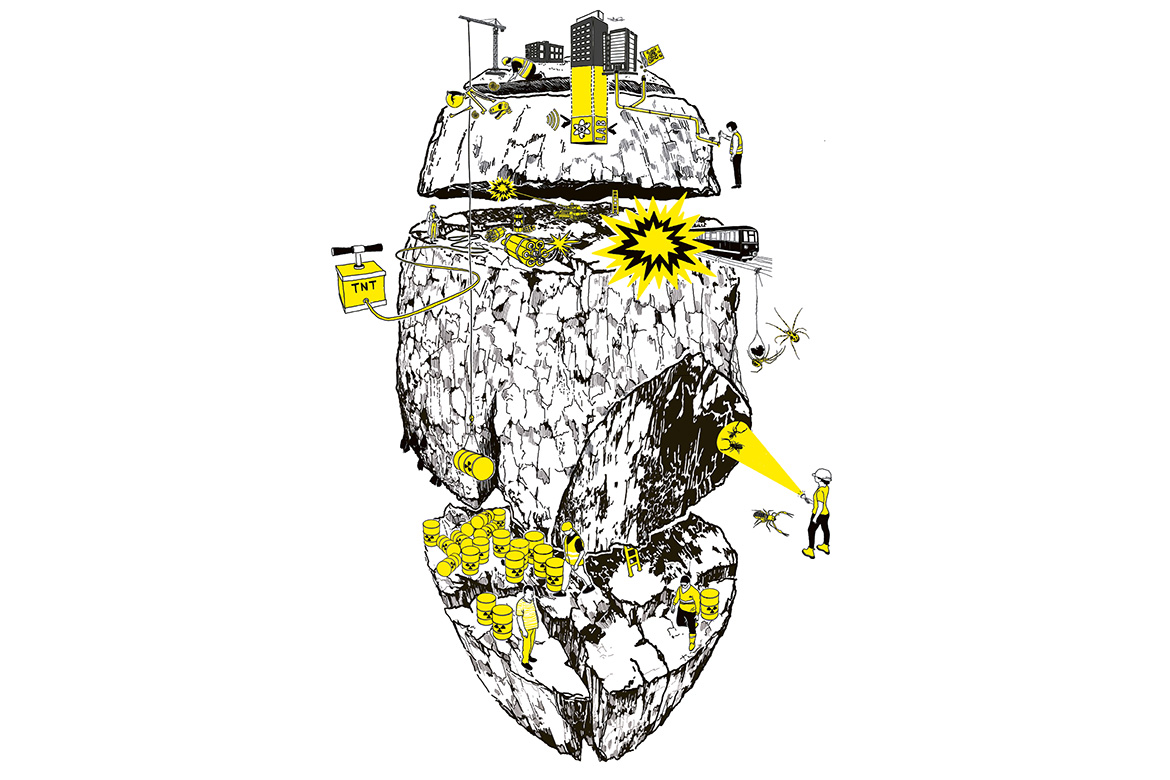MUSHROOMS
Underground fungi save forests
When they work well together, mycorrhizal fungi and trees thrive. This symbiosis may be leveraged in the fight against climate change.

The white threads of the soil fungus grow around the plant roots and form a mycorrhiza (a fungal root). An exchange of nutrients takes place at the contact points. | Image: Shutterstock
Strength is in union, especially between plants and certain mushrooms that live in symbiosis with their roots. It’s even more the case in terms of the fight against climate change. Here precisely lies a promising response from Nature itself, found in the close collaboration between certain fungi and the roots of plants. This association was first described some 140 years ago by the German biologist Albert Bernhard Frank. During an exploration aiming to assess the possibility of growing truffles in Prussia, Frank realised that the underground parts of these fungi are so closely tied in with the roots of trees that they form a sort of separate organ that Frank called mycorrhiza, from the Greek mýkēs, ‘fungus’, and rhiza, ‘root’.
Since then, thousands of scientific publications have confirmed the importance of this relationship which appeared with the first plants several million years ago. It’s also most probably the form of symbiosis that is most widespread and most vital in land ecosystems. The variety of mycorrhiza is surprising and the fungal species have diversified over the many steps in the evolution of plants.
At the Federal Institute for Forest, Snow and Landscape Research (WSL), Dr Martina Peter, the head of group, describes the two major groups of mycorrhizae: endomycorrhiza (or arbuscular mycorrhiza), which penetrates inside the roots and which is particularly important for agriculture and fruit trees, and ectomycorrhiza, which mainly concerns coniferous trees and Fagales (beech, oak, birch, etc.) in forests here and in the taiga just south of the Arctic Circle. More than 2,000 species and almost one third of the fruiting bodies of mushrooms visible to the naked eye are mycorrhizal fungi. Truffles, bay boletes, charcoal burners, saffron milk caps, chanterelles, as well as poisonous mushrooms like the fly agaric and the death cap are some further examples.
A buffer against drought
“Eighty percent of land plants live in symbiosis with a soil fungus that has a positive influence on their growth and also on crop yields”, says Marcel van der Heijden, the head of the research group on plant-soil interaction at Agroscope and professor of agroecology at the University of Zurich. Mushrooms gain sugar and amino acids produced through photosynthesis of the plants. In exchange they provide plants with water and nutrients, like nitrogen and phosphorus. “Mushrooms thereby offer a real nutritional support, even more important in stress conditions brought about through attacks by pathogens, heat, drought and pollutants”, he says.
Martina Peter compares mycorrhiza to a sort of living buffer: “During studies conducted on areas of very dry forest in Valais, we observed major changes in the fungal communities during periods of drought and heat. Entire communities change: some species die, others resist and spread. The reaction of trees to the heat and drought is therefore mitigated by the whole community of fungi”. According to van der Heijden, these rapid and probably reversible changes will not be able to save all ecosystems confronted by extreme conditions. But they do improve the resilience of plant communities, rapidly reduce plant stress and stabilise ecosystems. This is why the idea arose to use this natural treasure to strengthen plant roots by inoculating the earth with specific mushrooms selected to resist drought and heat. More than 100 species of mycorrhizal fungi of this kind had already been isolated in Switzerland, and full field testing has since started. “Microbiota-based inoculants from endomycorrhizal fungi are very good tools for farming”, says van der Heijden. There are multiple advantages to using them: they enrich the soil, make them more resilient to stress, help carbon capture, promote organic farming and thereby biodiversity in ecosystems, which is valuable in maintaining soil and plant resilience. “It’s a type of natural fertiliser that doesn’t require the use of chemicals, which themselves weaken fungal networks”, he says. Indeed, the high rate of nitrogenous residue stemming from agricultural fertilisation and nitrogen oxide emissions from vehicle traffic is a real enemy for symbiotic mushrooms. “In forest and on unspoiled land, plants and mushrooms have adapted to weak concentrations of nitrogen”, says Peter. “If the soil is too rich in nitrogen, trees tend to grow upwards and produce less sugar for the roots and fungi. Consequently, the latter struggle to survive. In nitrogen-polluted soil, diversity in fungal communities falls, some species die out and fail to be replaced by others. Their role as a buffer against stress is therefore weakened”. Change is too fast Peter wants to know, however, whether there are perils in interfering with the richness of the soil. This question is above all relevant to intervention in forests. “Ideally, the best thing would be to leave Nature to its own devices and capacity for resilience, because it’s possible that, in trying to resolve one problem, we bring about another. Nevertheless, climate change is very fast and we can already see that certain trees, like beech, probably won’t be able to adapt in time”. Both experts see it therefore as very important to continue research with a view to boosting our understanding of mycorrhizal fungi and their characteristics, on the one hand to use them to come to the aid of crops and trees, and on the other to preserve them to the fullest extent. “Even if they undergo changes when hit with climate stress, as long as they’re present, better adapted species will be able to develop there and be in a position to support plant life”, says Peter.




